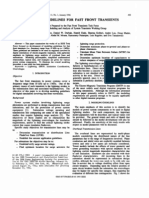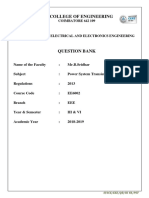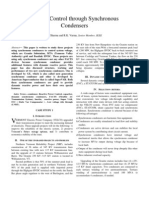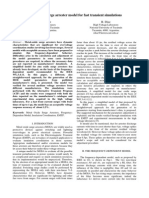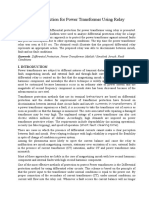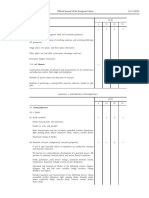DC Time Constant Estimation
Uploaded by
rasheed313DC Time Constant Estimation
Uploaded by
rasheed313Philipp Stachel
and Peter Schegner
Institute of Electrical Power Systems and High Voltage Engineering
TU Dresden, 01062 Dresden, Germany
Telephone: +49 (0) 351 46334374, Fax: +49 (0) 351 46339061
Email: philipp.stachel@tu-dresden.de
Email: peter.schegner@tu-dresden.de
AbstractThe knowledge of DC time constants in fault cur-
rents at system nodes is important to design the protection
system and validate the calculation models for power system
simulations. In this paper, we present methods to estimate
Thvenins impedance and DC time constants in fault currents
with application to disturbance records. Additionally, a compar-
ison between both parameters is shown.
We demonstrate that measurements of the DC time constant
of fault currents in disturbance records can be heavily distorted
by the protective current transformer and additional instrument
transformers (e. g. in the relay itself). This distortion depends on
the transformer type (P, TPX, TPY, TPZ) and burden. However,
by using current signal models and curve tting methods it is
still possible to estimate the required DC time constant and
Thvenins impedance.
The proposed methods are tested with simulated signals and
real measurements from different protective relays.
Index TermsPower system parameter estimation, protective
relaying, fault currents, impedance, signal analysis.
I. INTRODUCTION
Digital relays and disturbance recorders collect a lot of data
when a fault occurs in the electrical power transmission (high
voltage) and/or distribution (medium voltage) network. Anal-
ysis of the recorded data is usually done by skilled persons
but only when a serious disturbance occurs. In the future, an
automatic and deeper analysis of every disturbance record will
take place to extract additional information (e. g. DC time
constants, current transformer saturation [1]). Recently, such a
software system has been installed at an German transmission
system operator.
For protection engineers the knowledge of the short-circuit
power as well as the DC time constant in fault currents is
important to design the protection system (e. g. type and size
of current transformers, circuit breakers, minimum delays for
tripping, bus bars, relay settings). Both, DC time constant and
Thvenins impedance, are inuenced by grid expansions, the
state of circuit breakers (network topology), the fault type or
the distance. In most cases these parameters are not known or
imprecisely determined. For electrical power system modeling
and calculations these parameters differ at system nodes or
even with fault locations. Therefore, measured time constants
are also necessary for model validation.
II. RELEVANCE OF DC TIME CONSTANTS
The power system time constant T
N
represents the ratio of
resistance and reactance in the positive sequence system of a
pre-located network N at a node A (g. 1).
Z
N
=R
N
+j X
N
U
N
F
A
k3
Fig. 1. Network infeed model with 3-phase fault [2]
Thvenins impedance Z
N
depends on the actual switching
state of the power system but is also frequency dependant [3].
Therefore, not only one system time constant exists.
In this paper we only consider the fundamental frequency
components because they are relevant for short-circuit currents
with decaying DC components. The system time constant is
then dened by
T
N
=
L
N
R
N
=
X
N
2f
N
R
N
. (1)
Typical system time constants for high voltage networks are
about T
N
= 20 . . . 40 ms [4] while medium voltage networks
can have the whole range presented in table I.
TABLE I
RELATION BETWEEN SYSTEM TIME CONSTANT T
N
AND IMPEDANCE
RATIO X
N
/R
N
AT f
N
= 50 Hz
T
N
in ms 10 30 50 100 300
X
N
/R
N
3.1 9.4 15.7 31.4 94.2
The system time constant inuences the decaying char-
acteristics of the DC component of short-circuit currents.
The choice of type and size of current transformers, circuit
breakers, minimum delays for tripping
1
, bus bars and relay
1
The decay of the AC fault current amplitude can be faster than the DC
component at disturbances close to generators. In these cases, zero crossings
of the fault current in the rst periods might be missing . To switch of such
currents might be impossible and dangerous for the circuit breaker. [5], [2]
Modern Electric Power Systems 2010, Wroclaw, Poland MEPS'10 - paper 09.2
Estimation of DC Time Constants in Fault Currents
and Their Relation to Thvenins Impedance
settings depend on the short-circuit power and the DC time
constants. Therefore, the actual value of the system time
constant at the relay measuring point is important for the
design of current transformers for protection issues.
III. CALCULATION OF THVENINS IMPEDANCE IN
FREQUENCY DOMAIN
A. Proposed method
The considered positive sequence of a symmetrical power
system consisting of two sub-systems U
11
, Z
11
and U
21
, Z
21
connected by a line Z
L1
is shown in g. 2. The synchronous
U
11
Z
11
I
A1
Z
L1
U
21
Z
21
U
A1
Fig. 2. Positive sequence system of two symmetrical active sub-systems
connected by a line
sampled voltages u
A
and currents i
A
are measured at the
relay installation node A. The fundamental frequency positive
sequence phasors (symmetrical components) U
A1
and I
A1
(g. 2) are calculated form the measurements (e. g. disturbance
record).
Applying Kirchhoffs voltage law to g. 2 leads to
U
11
= Z
11
I
A1
+U
A1
(2)
with the voltage source
U
11
=
U
11
e
j11
. (3)
Under the assumptions
= const
11
= const (4)
U
11
= const Z
11
= const (5)
Thvenins impedance Z
11
can be calculated from two dif-
ferent (quasi-)stationary system states (pre-fault, fault and/or
post-fault state) with a lag t = t
2
t
1
as
U
11
(t
1
) = U
11
(t
2
) e
jt
(6)
Z
11
=
U
A1
(t
2
) e
jt
U
A1
(t
1
)
I
A1
(t
1
) I
A1
(t
2
) e
jt
. (7)
From the imaginary and the real part of Z
11
, the system time
constant can be calculated by
T
N
=
{Z
11
}
{Z
11
}
. (8)
Because differences in voltage and current are evaluated, we
call the proposed method Delta method [6]. We propose
to estimate the system frequency f
N
and the fundamental
frequency phasors U
A
and I
A
with an iterative Pronys method
[7], [8] because its results are more precise than by using a
FFT algorithm.
B. Limitations of the Delta method
Beside the fullled assumptions (4) and (5) the network
frequency f
N
must be calculated very precisly. For this, the
proposed Pronys method for estimating phasors is suitable.
Another requirement is, that the triggering transient system
event between the analysed stationary states must not effect
the system voltage U
11
. Here, disturbance records with high
load changes are more applicable than those with short-circuits
[6]. However, load changes normally wont trigger protection
relays and therefore arent feasible for analysing disturbance
records. By analysing fault current records the (in generally)
changed network topology by switching circuit breakers in the
case of clearing fault currents as well as the non-stationary
currents are challenging.
Another limitation of the Delta method is the need for
measurements of the total current infeed from the sub-system
to be analysed. In the case of recorded signals of a double
circuit line only parts of the (fault) current are measured by
the relay depending on the line impedances and fault location.
The user of this method has to make sure, that total currents
are applied otherwise the results will not be reliable.
C. Verication of the Delta method
Tests on simulated and real disturbance records with typical
sampling frequencies f
s
= 1 kHz were performed to evaluate
the accuracy and the applicability of the proposed method.
1) Test on simulated signals: The accuracy of the Delta
method was tested on simulated voltage and current wave-
forms. The used network model in DIGSILENT PowerFactory
is shown in g. 3.
R
Z
N
U
N
F
A
F
B
A B
load
line
Fig. 3. Simulated single feeded network model with measuring relay R and
two fault locations F
A
and F
B
Simulated network parameters:
nominal voltage of system U
N
= 220 kV
short circuit power S
N
= 1000 MVA
length of line l = 50 km
variation of system time constant T
N
{50, 100}ms
simulated load changes (LC)
inductive load S
load
= 250 MVA; PF = 0.95
load change S
load
{+10 %, +100 %} S
load
simulated short-circuits (SC)
fault type: k1E, k2, k2E bzw. k3
fault location at node A (0.1 % l) resp. B (99.9 % l)
fault impedance R
f
{0, 100}
Results of calculated system time constants for different sys-
tem events and references are presented in table II. The relative
error is less than 5 % in the case of analysing disturbance
records with short-circuits. The simulated small load change
2
does not induce big differences in voltages and currents. Thus,
the relative error is higher in this case.
TABLE II
CALCULATED SYSTEM TIME CONSTANTS AND ERRORS AT DIFFERENT
SIMULATED SYSTEM EVENTS
Reference T
N
= 50 ms T
N
= 100 ms
Event T
N
/ms error in % T
N
/ms error in %
+10 %
LC
47.08 -5.84 87.84 -12.16
+100 % 48.60 -2.80 94.55 -5.45
SC k1E
node A 48.89 -2.22 95.18 -4.82
node B 49.17 -1.67 94.93 -5.07
SC k2
node A 48.84 -2.32 95.48 -4.53
node B 48.92 -2.16 95.40 -4.60
SC k2E
node A 48.91 -2.17 96.43 -3.57
node B 48.90 -2.21 95.95 -4.05
SC k3
node A 48.79 -2.42 95.38 -4.62
node B 48.79 -2.43 95.07 -4.93
Simulations with different short-circuit power and fault
impedance R
f
were also performed obtaining relative errors
less than 5 %.
2) Test on real disturbance records: The applicability of
the proposed Delta method was tested on real data from a
German transmission system operator. The obtained system
time constants by analysing short-circuit disturbance records
were in the range of 20 ms to 40 ms. Even if the correct data
was not available, these values are typical for the high voltage
system.
IV. CALCULATION OF DC TIME CONSTANT IN TIME
DOMAIN
A. Relation between Thvenins impedance and system time
constant
The DC time constant of a decaying short-circuit current
is only identical to the system time constant in the case of
a 3-phase impedanceless fault close to the measuring node.
It also depends on the fault type, fault location and fault
impedance. Thus, every recorded fault current may lead to
a different DC time constant. Thvenins impedance as well
as the system time constant are not effected by these factors.
However, analysing the decaying DC component is useful to
validate used simulation models.
B. Proposed signal model and method
The measured short-circuit current at node A (g. 3) in time
domain can be expressed by
i
k
(t) = u
N
cos(t +
f
)
R + sin(t +
f
)
L
(
R)
2
+ (
L)
2
i
DC
exp
_
L
t
_
(9)
2
Load changes usually wont start relays or trigger disturbance recorders.
with the DC current amplitude
i
DC
=
u
N
(cos
f
R + sin
f
L)
(
R)
2
+ (
L)
2
i
k
(t
0
) (10)
where
R resp.
L represent all resistive resp. inductive
parts of the fault loop (network/system, line, fault impedance).
The ratio T
DC
=
L/
R is the DC time constant for that
particular fault. The DC signal components in (9) and (10)
depend, amongst other things, on the fault inception angle
f
and therefore do not appear signicantly in all disturbance
records.
When faults occur close to power stations the network
voltage u
N
as well as Thvenins impedance (esp. X
N
) cant
be assumed to be constant. In these cases, Equation (9)
and (10) are not exact and the following method might fail.
However, most faults in the ENTSO-E power system occur far
from generators in the sense of [2] and the model is valid.
Several methods have been tested to estimate the DC time
constant:
Pronys method (original, least-squares, iteratively
reweighted least squares)
directly analysing the DC decay
least squares curve tting by applying signal models
solving with
LevenbergMarquardt algorithm
Particle swarm optimisation
The best results (accuracy, robustness and calculation speed)
were obtained using a least squares curve tting and the
LevenbergMarquardt algorithm.
The parameter vector x = (C
oset
, C
1
, T
1
) of the signal
model of the decaying DC component (sampling period T
s
)
i
model
(t) = i
model
(k T
s
) = C
oset
+C
1
exp (t/T
1
) (11)
can be estimated by solving the least square problem
min
x
k
[i
model
(k, x) i
DC
(k)]
2
. (12)
The supporting points i
DC
(k) are extracted from the relays
recorded fault current i by applying a FIR notch lter w
(ltering the fundamental frequency f
0
= f
N
) [9].
w(k) =
_
_
1 for k {1, 3}
2 cos (2f
0
T
s
) for k = 2
0 otherwise
(13)
i
DC
(k) =
3
j=1
w(j) i(k + 1 j) (14)
The automated signal analysis estimates the DC time con-
stant T
1
and consists of the following steps:
1) automated segmentation of analogue current signal [10]
and selection of short circuit segment with signicant
DC amplitude
2) extraction of DC signal component by applying (14)
3) guessing starting values for x with simple signal analysis
4) estimation of signal parameter x by curve tting algo-
rithm (12)
V. SEPARATION OF MORE THAN ONE DC TIME CONSTANT
The previous assumptions of undistorted measurements of
the short-circuit current i
k
(t) arent fullled in a typical
circuitry as shown in g. 4.
The recording device (relay or disturbance recorder) is
attached to the secondary winding of the main protection
current transformer ct, which transduces the primary current
i
k
(t). The internal current transformer R inside the relay also
inuences the sampled current signal. R
1
in g. 4 includes
R
2
network
R
1
protection current
transformer ct
protection relay / disturbance recorder
A/D converter
#
i
k
= i
pri
F
internal current
transformer R
i
sec
i
meas
Fig. 4. Typical series connection of several current transformers for digital
relays or disturbance recorders
the resistances of the main current transformer ct as well as
the wiring to the relay. The internal resistances (burden and
secondary winding of current transformer) are modelled with
R
2
. The proposed method should be able to estimate the DC
time constant T
DC
of i
k
from measurements i
meas
.
Depending on the type of current transformers (closed iron
core or linearised with air gaps in magnetic core) the DC
components are transduced differently. For best results of the
estimated time constant T
DC
the DC component should be
transduced ideally. However, decaying DC components effect
the protection algorithms (e.g. based on FFT) applied and
therefore linearised current transformers are widely used in
relays but also for the main protection transformers (TPY and
TPZ types) [11], [4].
A. Enhanced signal model
A simplied model of a current transformer is shown in
g. 5. Neglecting
3
the leakage inductance L
and considering
L R
ct
L
h
i
pri
' i
sec
i
h
L
B
R
B
Fig. 5. Simplied model of current transformer
3
In general fullled, because L < L
B
L
h
.
only ohmic burden L
B
0 the following equations are valid.
i
pri
= i
h
+i
sec
(15)
0 =
di
h
dt
L
h
i
sec
(R
ct
+R
B
) (16)
Applying (15) to (16) gives
0 =
di
pri
dt
di
sec
dt
i
sec
R
ct
+ R
B
L
h
(17)
The signal model for an exponential decaying DC component
in the primary current with a time constant T
DC
can be
expressed as
i
pri
(t) = C
1
exp
_
t
T
DC
_
. (18)
Applying (18) to (17) gives the inhomogeneous differential
equation
0 =
C
1
T
DC
exp
_
t
T
DC
_
+
di
sec
dt
+
i
sec
T
ct
(19)
with the time constant of the secondary current loop
4
T
ct
=
L
h
R
ct
+R
B
. (20)
Considering the initial conditions i
h
(t
0
) = 0 and i
sec
(t
0
) =
i
pri
(t
0
) = C
1
the solution of (19) is
i
sec
(t) =
C
1
T
ct
T
DC
_
T
DC
e
t
T
ct
T
ct
e
t
T
DC
_
. (21)
The secondary current of the main current transformer ct
i
sec
is transduced by the internal current transformer R in
the relay (g. 4) and therefore the signal model needs further
extensions
5
. In (17) i
pri
becomes i
sec
from (21) giving
0 =
di
sec
dt
di
meas
dt
i
meas
T
R
(22)
with the relay time constant T
R
.
As the solution of (22) the measured current is obtained
which is nally sampled and recorded by the device
i
meas
(t) =
C
2
T
R
T
ct
_
T
R
e
t
T
ct
T
ct
e
t
T
R
+T
R
T
ct
_
e
t
T
DC
e
t
T
R
T
DC
T
R
t
T
DC
e
t
T
ct
T
DC
T
ct
__
(23)
Depending on the time constants T
ct
and T
R
a distortion of
the DC signal component takes place.
The curve tting signal model depends on the assumed
number of DC time constants in the signal. Equation (11)
ts this problem best, if T
ct
and T
R
can be neglected (i. e.
T
ct
, T
R
). If only one time constant can be neglected,
(21) is valid. In all other cases, (23) should be adapted for the
tting model.
4
In this paper we call it current transformer time constant. If Tct ,
Tct can be substituted by T
R
in the following equations.
5
Only necessary if more than one secondary time constant is relevant (see
footnote 4).
B. Measurement of DC time constant from digital relays
The time constant of some relays were measured to get
an idea how much the short circuit current is distorted by
the recording devices themselves. For this task an articial
rectangular current waveform was feed into the DUTs (dis-
tance and differential protection relays). The obtained recorded
waveforms were analysed and the time constants T
R
were es-
timated. Table III summarizes some results of selected relays.
Manufacturer C uses linearised current transformers with air
TABLE III
ESTIMATED TIME CONSTANTS OF SELECTED PROTECTION RELAYS
Manufacturer Device Time constant
A 1 T
R
85 ms
B 2 T
R
65 ms
C 3 T
R
11 ms
C 4 T
R
16 ms
gaps. The DC signal components are extremely distorted.
C. Verication of method
The proposed methods for estimating the DC time constants
in decaying current signals were tested on simulated and
recorded current signals. For simulations the network model
in g. 3 with an additional current transformer model (g. 5)
was used assuming a 3-phase fault at fault location F
A
. In
this particular case the DC time constant T
DC
in i
k
equals the
system time constant T
N
. Two cases were considered:
1) only the system time constant is relevant
T
N
{10, 30, 50, 100, 300}ms
2) the system time constant and the current transformer
time constant are present
T
N
{50, 100}ms, T
ct
{10, 50, 100, 200, 300}ms
Applying these simulated current signals to protection relays
(table III) with an OMICRON CMC 256, real measurements
are obtained after readout of the disturbance data.
1) Test on simulated signals: The methods were tested on
the simulated data with no noise rst a maximum of two DC
time constants is present. Table IV presents the results for all
three signal models. Highlighted in grey are the results were
the model ts the problem best
6
. If estimated time constants
are higher than a second is shown in table IV.
In the rst ve rows of table IV results from case 1 are
presented. Signal model 1 gives the best tting results and also
estimates the DC time constant with negligible error. Signal
model 2 and 3 take more DC time constants into account.
The additional estimated times are signicantly higher than
one second and therefore can be neglected.
In rows 6-15 of table IV results from case 2 are shown.
Signal model 2 and 3 give good estimates of the two DC time
constants. Signal model 1 estimates only one time constant
1
T
1
T
ct
+
1
T
N
(24)
6
Not always the best results.
TABLE IV
ANALYSIS OF SIMULATED CURRENT SIGNALS WITH WINDOW LENGTH
160 ms ESTIMATED TIME CONSTANTS IN MILLISECONDS
Reference Model 1 Model 2 Model 3
Tct T
N
T T
1
T
2
T
1
T
2
T
3
10 10.0 10.0 - 10.0
30 30.0 30.0 - 30.0
50 50.0 50.0 - 50.0
100 100.0 100.0 - 100.0
300 299.6 300.4 - 300.4
10 50 6.7 38.7 10.5 229.1 51.6 10.0
10 100 8.4 85.3 10.1 485.8 101.5 10.0
50 50 23.5 49.2 49.2 50.9 49.1
50 100 34.8 95.4 50.6 99.6 50.1
100 50 34.8 95.3 50.6 100.5 50.0
100 100 56.7 99.4 99.4 106.1 95.0
200 50 43.4 194.3 50.1 195.3 50.1
200 100 78.1 196.7 100.3 202.8 99.7
300 50 46.4 292.4 50.0 - 283.4 50.0
300 100 87.2 294.1 100.2 297.4 100.1
which is always smaller than the smallest real time constant
present.
The analysed window length (for curve tting) is 160 ms. In
general, most faults in the German high voltage network are
cleared after 80 . . . 160 ms. The chosen window length directly
inuences the highest possible time constant to be estimated.
In the presence of noise the window length must be longer
than the highest time constant to be estimated.
As seen from table IV, it is possible to estimate more than
one DC time constant obtaining less than 5 % error with the
proposed curve tting method. Higher time constants require
longer lasting short circuit currents (longer window length).
However, the latter arent typical for disturbance records in
electrical power systems.
2) Test on real disturbance records: The methods were
tested with recorded current signals a minimum of two and a
maximum of three DC time constants are present. In Table V
the estimated parameters are shown for device 1. In case 1
TABLE V
ANALYSIS OF RECORDED CURRENT SIGNALS (DEVICE 1) WITH WINDOW
LENGTH 160 ms ESTIMATED TIME CONSTANTS IN MILLISECONDS
Reference Model 1 Model 2 Model 3
Tct T
N
T T
1
T
2
T
1
T
2
T
3
10 8.7 110.6 9.9 -523.2 98.5 10.0
30 22.2 90.2 30.2 -522.6 79.7 30.7
50 32.7 63.4 63.6 -314.4 61.5 61.1
100 50.6 90.3 90.3 -229.9 93.0 92.9
300 81.4 268.3 94.7 - 239.5 96.0
10 50 6.3 32.1 10.7 -126.5 30.6 10.3
10 100 7.5 54.4 10.3 61.3 557.7 10.2
50 50 17.8 39.5 39.5 42.8 280.7 42.8
50 100 25.1 51.5 51.5 -192.9 50.9 50.6
100 50 25.5 52.0 52.0 -191.0 51.4 51.3
100 100 35.6 67.7 67.7 -197.8 68.5 69.1
200 50 30.1 59.3 59.3 -224.4 58.1 58.0
200 100 42.8 78.9 78.6 -256.2 77.6 77.6
300 50 30.4 72.6 50.7 -498.4 58.0 58.0
300 100 46.1 83.5 83.5 -236.1 83.3 84.9
the system time constant T
N
as well as the specic relay time
constant T
R
are estimated with model 2 and 3 in most cases
but cant be assigned without additional knowledge about the
recording relay. If the two DC time constants are similar (i. e.
T
N
{50, 100}ms) the estimates are of poor quality.
To improve the results, the curve tting signal models (21)
and (23) were modied with the known relay time constant
T
R
from table III. The curve tting results are presented in
table VI for device 1. In case 1 the system time constant can
TABLE VI
ANALYSIS OF RECORDED CURRENT SIGNALS (DEVICE 1) WITH WINDOW
LENGTH 160 ms AND KNOWN RELAY TIME CONSTANT ESTIMATED
TIME CONSTANTS IN MILLISECONDS
Reference Model 1 Model 2 Model 3
Tct T
N
T T
1
T
2
T
1
T
2
T
3
10 8.7 10.6 85.0 -332.4 10.2 85.0
30 22.2 31.1 85.0 - 30.3 85.0
50 32.7 50.2 85.0 841.0 52.7 85.0
100 50.6 96.2 85.0 -228.1 103.5 85.0
300 81.4 -698.0 85.0 - - 85.0
10 50 6.3 7.3 85.0 72.4 9.5 85.0
10 100 7.5 8.9 85.0 178.4 9.9 85.0
50 50 17.8 23.6 85.0 120.7 32.3 85.0
50 100 25.1 35.7 85.0 207.8 43.9 85.0
100 50 25.5 36.3 85.0 200.7 45.0 85.0
100 100 35.6 56.0 85.0 167.8 80.9 85.0
200 50 30.1 44.8 85.0 321.2 51.6 85.0
200 100 42.8 73.3 85.0 514.8 82.0 85.0
300 50 30.4 45.6 85.0 47.2 85.0
300 100 46.1 82.1 85.0 -232.7 83.7 85.0
be estimated with small errors by signal model 2 and 3 if
T
N
100 ms. In case 2 (three time constants are present)
model 3 estimates the smaller time constant in most cases
with errors less than 5 %. Similar time constants are incorrectly
estimated. Overall, the estimates for the DC time constants are
signicantly better than without considering the relay time
constant as presented in table V. However, in a practical
application more than two DC time constants cant be correctly
estimated and assigned.
In case 1 (e. g. using closed iron core protection current
transformers, P-type with T
ct
[12]) the estimated
DC time constants can be assigned non-ambiguously to T
N
and T
R
(dark grey results in table VI). A non-ambiguous
assignment is not practical if TPY or TPZ-type protection
current transformer are used (case 2).
VI. CONCLUSION
In this paper we presented the relation between DC time
constants in fault currents, Thvenins impedance and the
system time constant. The knowledge of these parameters at
a specic node in the electrical power system is important for
the protection system design as well as network calculations.
Measurements from relays or disturbance recorders are avail-
able for many system nodes and faults and they are very useful
for estimating these time constants.
The estimation of the system time constant needs voltages
and current waveforms (e. g. from distance protection relays).
Calculation with the proposed Delta method is only possible
if the whole (fault) current is recorded. The results are inde-
pendent from fault type or fault resistance and they are of high
accuracy.
By applying signal models and curve tting techniques,
we presented methods to estimate the DC time constants in
decaying fault current waveforms from disturbance records.
The DC time constant of the measured fault current loop
depends on fault type, impedance and location.
A distortion of the decaying DC signal component can
be introduced by additional current transformers in the mea-
suring circuitry. It is possible to separate these additional
time constants if they differ signicantly. A non-ambiguously
assignment to the DC time constant of the fault current loop
is only possible in the case of further known conditions
(e. g. type of used current transformers, protection relay time
constant).
REFERENCES
[1] P. Stachel and P. Schegner, Detection and correction of current trans-
former saturation effects in secondary current signals, in IEEE PES
General Meeting. IEEE, Jul. 2009.
[2] CENELEC, Short-circuit currents in three phase a.c. systems part 0:
Calculation of currents, European Committee for Electrotechnical Stan-
dardization Standard EN 60 909-0, Aug. 2001.
[3] J.-H. Hong and J.-K. Park, A time-domain approach to transmission
network equivalents via prony analysis for electromagnetic transient
analysis, IEEE Transactions on Power Systems, vol. 10, no. 4, pp.
17891797, Nov. 1995.
[4] G. Ziegler, Numerical Distance Protection Principles and Applica-
tions, 3rd ed. Erlangen: Publicis Corporate Publishing, Mar. 2008.
[5] H.-J. Koglin, Der abklingende Gleichstrom beim Kurzschluss in
Energieversorgungsnetzen, Ph.D. dissertation, Technische Hochschule
Darmstadt, Feb. 1971.
[6] P. Schwaegerl, Methoden und Verfahren zur messtechnischen Bestim-
mung des Netzquivalents, Ph.D. dissertation, TU Dresden, Feb. 2002.
[7] C. W. Therrien and C. H. Valasco, An iterative extension of pronys
method for arma signal medeling, Naval Postgraduate School, Mon-
terey, California, Tech. Rep. NPSEC-93-025, Sep. 1993.
[8] R. ivanovi c, P. Schegner, O. Seifert, and G. Pilz, Identication of the
resonant-grounded system parameters by evaluating fault measurement
records, IEEE Transactions on Power Delivery, vol. 19, no. 3, pp. 1085
1090, Jul. 2004.
[9] D. W. Tufts and P. D. Fiore, Simple, effective estimation of frequency
based on pronys method, in Proc. IEEE International Conference on
Acoustics, Speech, and Signal Processing ICASSP-96, vol. 5, May 710,
1996, pp. 28012804.
[10] P. Stachel, R. ivanovi c, and P. Schegner, Enhanced segmentation
of disturbance records by adaptive thresholding, in Power System
Computation Conference, Jul. 2008.
[11] CENELEC, Instrument transformers part 6: Requirements for pro-
tective current transformers for transient performance, European Com-
mittee for Electrotechnical Standardization Standard EN 60 044-6, Mar.
1999.
[12] , Instrument transformers part 1: Current transformers, European
Committee for Electrotechnical Standardization Standard EN 60 044-1,
Aug. 1999.
You might also like
- Civil Design and Construction of 132kv 66kV and 33kV Substation100% (7)Civil Design and Construction of 132kv 66kV and 33kV Substation31 pages
- Simulations of Lightning Impulse Residual Voltage Test of Surge Arresters in Matlab-Simulink100% (1)Simulations of Lightning Impulse Residual Voltage Test of Surge Arresters in Matlab-Simulink6 pages
- A Transfer Function Approach To Harmonic Filter DesignNo ratings yetA Transfer Function Approach To Harmonic Filter Design15 pages
- Circuit Analysis of Ac Power System-Edith Clarke Volume I, II100% (1)Circuit Analysis of Ac Power System-Edith Clarke Volume I, II4 pages
- IEC GOOSE (Generic Object Oriented Substation Events) Messaging ImplementationNo ratings yetIEC GOOSE (Generic Object Oriented Substation Events) Messaging Implementation7 pages
- Simulation of Some Power System, Control System and Power Electronics Case Studies Using Matlab and PowerWorld SimulatorFrom EverandSimulation of Some Power System, Control System and Power Electronics Case Studies Using Matlab and PowerWorld SimulatorNo ratings yet
- VSC-FACTS-HVDC: Analysis, Modelling and Simulation in Power GridsFrom EverandVSC-FACTS-HVDC: Analysis, Modelling and Simulation in Power GridsNo ratings yet
- Advantages and Applications of Zigzag Transformer - Engineering Tutorial PDFNo ratings yetAdvantages and Applications of Zigzag Transformer - Engineering Tutorial PDF4 pages
- Busbar Protection - Busbar Differential: Best Practice and Recommendations100% (1)Busbar Protection - Busbar Differential: Best Practice and Recommendations57 pages
- Modeling Guidelines For Fast Front TransientsNo ratings yetModeling Guidelines For Fast Front Transients14 pages
- Auto Transformer Insulation Coordination StudyNo ratings yetAuto Transformer Insulation Coordination Study6 pages
- CT Saturation Tolerance For 87L Applications100% (1)CT Saturation Tolerance For 87L Applications26 pages
- Examples Ferroresonance in High Voltage Power System: N. Jacobson, Membec IEEENo ratings yetExamples Ferroresonance in High Voltage Power System: N. Jacobson, Membec IEEE7 pages
- Analysis of Active Power Flow Control With Phase Shifting Transformer in AC Transmission LineNo ratings yetAnalysis of Active Power Flow Control With Phase Shifting Transformer in AC Transmission Line7 pages
- Svs College of Engineering: COIMBATORE 642 109100% (1)Svs College of Engineering: COIMBATORE 642 10934 pages
- Differential Protection For Special Industrial Transformers: Zoran Gajic, Member, IEEENo ratings yetDifferential Protection For Special Industrial Transformers: Zoran Gajic, Member, IEEE6 pages
- Zig Zag Transformer Applications and Advantages - ECE Tutorials100% (1)Zig Zag Transformer Applications and Advantages - ECE Tutorials4 pages
- Transformer Inrush Currents and Protection 2603 003 A00100% (2)Transformer Inrush Currents and Protection 2603 003 A004 pages
- Current Harmonic Analysis of Multi Pulse Diode Rectifiers With Phase Shifting TransformerNo ratings yetCurrent Harmonic Analysis of Multi Pulse Diode Rectifiers With Phase Shifting Transformer5 pages
- VIZIMAX - CIGRE Toronto - Using A Controlled Switching Device For A Power Transformer PDFNo ratings yetVIZIMAX - CIGRE Toronto - Using A Controlled Switching Device For A Power Transformer PDF8 pages
- Temporary Overvoltages Following Transformer EnergizingNo ratings yetTemporary Overvoltages Following Transformer Energizing3 pages
- Volatge Control Through Synchronous Condensers - Rahul SharmaNo ratings yetVolatge Control Through Synchronous Condensers - Rahul Sharma8 pages
- Sequence Impedance in Different Power Equipments50% (2)Sequence Impedance in Different Power Equipments7 pages
- 3.2 Overexcitation and Overvoltage Protection100% (1)3.2 Overexcitation and Overvoltage Protection6 pages
- NERC Protection System Protection Fundamentals Public 060210No ratings yetNERC Protection System Protection Fundamentals Public 06021055 pages
- Ferroresonance at Open Phase Operating Conditions100% (1)Ferroresonance at Open Phase Operating Conditions4 pages
- Air Core Reactor Applications Current Limiting Reactors: UnrestrictedNo ratings yetAir Core Reactor Applications Current Limiting Reactors: Unrestricted24 pages
- Virtual Instrument Based Fault Classification in Power Transformers Using Artificial Neural NetworksNo ratings yetVirtual Instrument Based Fault Classification in Power Transformers Using Artificial Neural Networks5 pages
- Switching Power Supplies:: Analysis of Waveform Distortion and Absorbed PowersNo ratings yetSwitching Power Supplies:: Analysis of Waveform Distortion and Absorbed Powers6 pages
- Measurement System For Transformer Inrush Current Higher Harmonics DeterminationNo ratings yetMeasurement System For Transformer Inrush Current Higher Harmonics Determination6 pages
- Fault Resistance, Location and Inception Angle Effects On DC Offset of The Fault CurrentsNo ratings yetFault Resistance, Location and Inception Angle Effects On DC Offset of The Fault Currents6 pages
- Differential Protection For Power Transformer Using RelayNo ratings yetDifferential Protection For Power Transformer Using Relay5 pages
- Control Discrepancy Switch Type BM2-SM2No ratings yetControl Discrepancy Switch Type BM2-SM212 pages
- Calculations For Short Circuit Withstand Capability of A Distribution TransformerNo ratings yetCalculations For Short Circuit Withstand Capability of A Distribution Transformer9 pages
- Pressure Relief Device Messko-Data SheetNo ratings yetPressure Relief Device Messko-Data Sheet6 pages
- Efficient CVSL Based Full Adder Realizations: Kirti Gupta', Shrey Bagga2 and Neeta PandelNo ratings yetEfficient CVSL Based Full Adder Realizations: Kirti Gupta', Shrey Bagga2 and Neeta Pandel5 pages
- Kenwood Kac-529s (2sc5099lb 2sa1907lb Irfiz44n Upc494c)No ratings yetKenwood Kac-529s (2sc5099lb 2sa1907lb Irfiz44n Upc494c)8 pages
- How To Program ESP8266 in Lua Getting Started With ESP8266 (NodeMCU Dev Kit) in Lua (Jayakumar, Magesh)100% (1)How To Program ESP8266 in Lua Getting Started With ESP8266 (NodeMCU Dev Kit) in Lua (Jayakumar, Magesh)141 pages
- General Description: Micro Mullion Proximity ReaderNo ratings yetGeneral Description: Micro Mullion Proximity Reader2 pages
- Dressler ARA-2000 Active Antenna - What's Inside ?No ratings yetDressler ARA-2000 Active Antenna - What's Inside ?7 pages
- Thyristor Based Speed Control Techniques of DC Motor: A Comparative AnalysisNo ratings yetThyristor Based Speed Control Techniques of DC Motor: A Comparative Analysis7 pages
- UNIT 3 Advanced Signals & Systems Questions and Answers - Sanfoundry PDFNo ratings yetUNIT 3 Advanced Signals & Systems Questions and Answers - Sanfoundry PDF5 pages
- Manual Jaguar Instrumentation and Warning SystemsNo ratings yetManual Jaguar Instrumentation and Warning Systems86 pages
- n188 K8ak-Ls Conductive Level Controller Datasheet enNo ratings yetn188 K8ak-Ls Conductive Level Controller Datasheet en12 pages
- Civil Design and Construction of 132kv 66kV and 33kV SubstationCivil Design and Construction of 132kv 66kV and 33kV Substation
- Simulations of Lightning Impulse Residual Voltage Test of Surge Arresters in Matlab-SimulinkSimulations of Lightning Impulse Residual Voltage Test of Surge Arresters in Matlab-Simulink
- A Transfer Function Approach To Harmonic Filter DesignA Transfer Function Approach To Harmonic Filter Design
- Circuit Analysis of Ac Power System-Edith Clarke Volume I, IICircuit Analysis of Ac Power System-Edith Clarke Volume I, II
- IEC GOOSE (Generic Object Oriented Substation Events) Messaging ImplementationIEC GOOSE (Generic Object Oriented Substation Events) Messaging Implementation
- Simulation of Some Power System, Control System and Power Electronics Case Studies Using Matlab and PowerWorld SimulatorFrom EverandSimulation of Some Power System, Control System and Power Electronics Case Studies Using Matlab and PowerWorld Simulator
- VSC-FACTS-HVDC: Analysis, Modelling and Simulation in Power GridsFrom EverandVSC-FACTS-HVDC: Analysis, Modelling and Simulation in Power Grids
- Advantages and Applications of Zigzag Transformer - Engineering Tutorial PDFAdvantages and Applications of Zigzag Transformer - Engineering Tutorial PDF
- Busbar Protection - Busbar Differential: Best Practice and RecommendationsBusbar Protection - Busbar Differential: Best Practice and Recommendations
- Examples Ferroresonance in High Voltage Power System: N. Jacobson, Membec IEEEExamples Ferroresonance in High Voltage Power System: N. Jacobson, Membec IEEE
- Analysis of Active Power Flow Control With Phase Shifting Transformer in AC Transmission LineAnalysis of Active Power Flow Control With Phase Shifting Transformer in AC Transmission Line
- Differential Protection For Special Industrial Transformers: Zoran Gajic, Member, IEEEDifferential Protection For Special Industrial Transformers: Zoran Gajic, Member, IEEE
- Zig Zag Transformer Applications and Advantages - ECE TutorialsZig Zag Transformer Applications and Advantages - ECE Tutorials
- Transformer Inrush Currents and Protection 2603 003 A00Transformer Inrush Currents and Protection 2603 003 A00
- Current Harmonic Analysis of Multi Pulse Diode Rectifiers With Phase Shifting TransformerCurrent Harmonic Analysis of Multi Pulse Diode Rectifiers With Phase Shifting Transformer
- VIZIMAX - CIGRE Toronto - Using A Controlled Switching Device For A Power Transformer PDFVIZIMAX - CIGRE Toronto - Using A Controlled Switching Device For A Power Transformer PDF
- Temporary Overvoltages Following Transformer EnergizingTemporary Overvoltages Following Transformer Energizing
- Volatge Control Through Synchronous Condensers - Rahul SharmaVolatge Control Through Synchronous Condensers - Rahul Sharma
- NERC Protection System Protection Fundamentals Public 060210NERC Protection System Protection Fundamentals Public 060210
- Air Core Reactor Applications Current Limiting Reactors: UnrestrictedAir Core Reactor Applications Current Limiting Reactors: Unrestricted
- Power System Wide-area Stability Analysis and ControlFrom EverandPower System Wide-area Stability Analysis and Control
- Virtual Instrument Based Fault Classification in Power Transformers Using Artificial Neural NetworksVirtual Instrument Based Fault Classification in Power Transformers Using Artificial Neural Networks
- Switching Power Supplies:: Analysis of Waveform Distortion and Absorbed PowersSwitching Power Supplies:: Analysis of Waveform Distortion and Absorbed Powers
- Measurement System For Transformer Inrush Current Higher Harmonics DeterminationMeasurement System For Transformer Inrush Current Higher Harmonics Determination
- Fault Resistance, Location and Inception Angle Effects On DC Offset of The Fault CurrentsFault Resistance, Location and Inception Angle Effects On DC Offset of The Fault Currents
- Differential Protection For Power Transformer Using RelayDifferential Protection For Power Transformer Using Relay
- Calculations For Short Circuit Withstand Capability of A Distribution TransformerCalculations For Short Circuit Withstand Capability of A Distribution Transformer
- Efficient CVSL Based Full Adder Realizations: Kirti Gupta', Shrey Bagga2 and Neeta PandelEfficient CVSL Based Full Adder Realizations: Kirti Gupta', Shrey Bagga2 and Neeta Pandel
- Kenwood Kac-529s (2sc5099lb 2sa1907lb Irfiz44n Upc494c)Kenwood Kac-529s (2sc5099lb 2sa1907lb Irfiz44n Upc494c)
- How To Program ESP8266 in Lua Getting Started With ESP8266 (NodeMCU Dev Kit) in Lua (Jayakumar, Magesh)How To Program ESP8266 in Lua Getting Started With ESP8266 (NodeMCU Dev Kit) in Lua (Jayakumar, Magesh)
- General Description: Micro Mullion Proximity ReaderGeneral Description: Micro Mullion Proximity Reader
- Dressler ARA-2000 Active Antenna - What's Inside ?Dressler ARA-2000 Active Antenna - What's Inside ?
- Thyristor Based Speed Control Techniques of DC Motor: A Comparative AnalysisThyristor Based Speed Control Techniques of DC Motor: A Comparative Analysis
- UNIT 3 Advanced Signals & Systems Questions and Answers - Sanfoundry PDFUNIT 3 Advanced Signals & Systems Questions and Answers - Sanfoundry PDF
- n188 K8ak-Ls Conductive Level Controller Datasheet enn188 K8ak-Ls Conductive Level Controller Datasheet en















